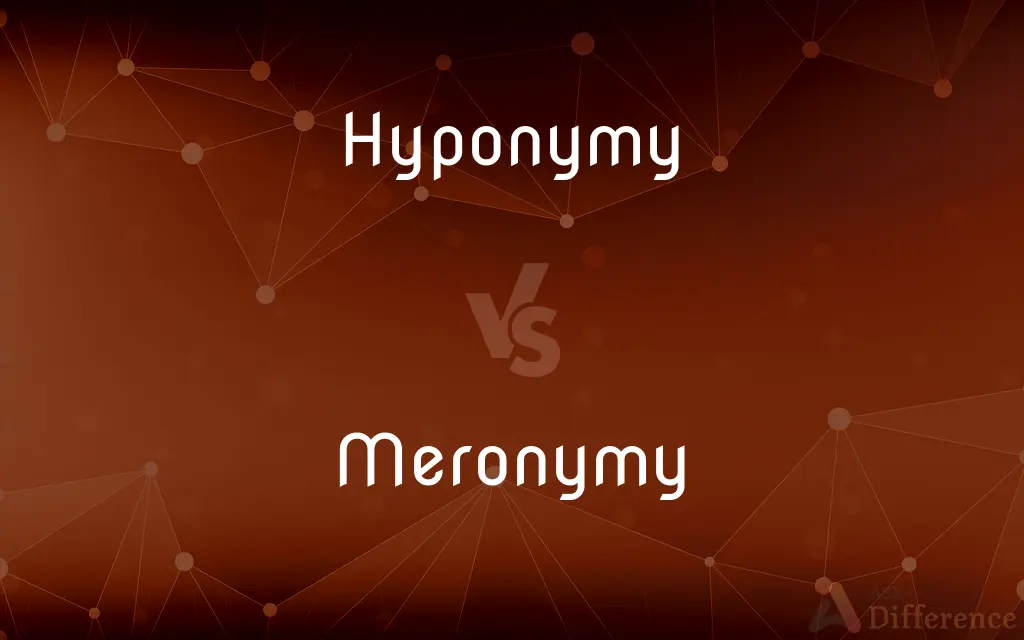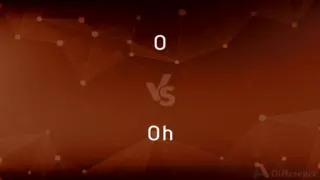Hyponymy vs. Meronymy — What's the Difference?
Edited by Tayyaba Rehman — By Maham Liaqat — Updated on April 7, 2024
Hyponymy refers to a word relationship where the meaning of one word is included within another, whereas meronymy involves a part-whole relationship between words.

Difference Between Hyponymy and Meronymy
Table of Contents
ADVERTISEMENT
Key Differences
Hyponymy is a semantic relationship where the meaning of one term (hyponym) is fully included within another (hypernym), specifying a subtype within a general category. For example, "rose" is a hyponym of "flower," meaning every rose is a flower. Meronymy, on the other hand, describes a part-to-whole relationship where one term (meronym) denotes a part of something else (holonym). For instance, "wheel" is a meronym of "car," indicating that a wheel is part of a car.
In hyponymy, the broader term (hypernym) categorizes and encompasses a range of narrower terms (hyponyms), such as "animal" being a hypernym for "dog," "cat," and "horse." This relationship structures knowledge by grouping specific instances under general concepts. In contrast, meronymy connects items based on their physical or conceptual composition, like "page" being a meronym of "book," illustrating how complex objects or concepts are made up of smaller components.
Hyponymy is crucial for understanding linguistic organization and vocabulary development, as it helps in learning new words through their associations with familiar concepts. It enables categorization and generalization in language learning. Meronymy, conversely, aids in understanding and describing the structure or composition of objects and concepts, enhancing our ability to detail and explain the physical or conceptual makeup of things.
The understanding of hyponymy facilitates language efficiency by allowing speakers to communicate using general or specific terms as needed, depending on the context or the listener's knowledge. For example, one might use "bird" to refer broadly to a group of animals or "sparrow" for specificity. Whereas, meronymy enriches descriptive language, enabling precise references to parts of a whole, such as describing a scene by mentioning "leaves" and "branches" instead of just "tree."
While hyponymy sorts concepts into hierarchies from general to specific, meronymy reveals the interconnectedness of things by delineating how entities are composed or related in a part-to-whole manner. Both relationships play complementary roles in organizing knowledge and facilitating clear, effective communication.
ADVERTISEMENT
Comparison Chart
Relationship Type
Inclusion (subtype-to-type)
Part-to-whole
Example
"Sparrow" is a hyponym of "bird."
"Wheel" is a meronym of "car."
Focus
Categorization and specificity
Composition and structure
Linguistic Function
Facilitates vocabulary development and categorization
Enhances descriptive detail and understanding of composition
Example in Sentence
A robin is a bird.
A door is part of a car.
Compare with Definitions
Hyponymy
Relationship where one word's meaning is included within another.
A daffodil is a flower.
Meronymy
Useful for detailed descriptions.
A keyboard is part of a computer.
Hyponymy
Involves specificity within a category.
An oak is a type of tree.
Meronymy
Facilitates understanding of composition.
An engine is a component of a vehicle.
Hyponymy
Aids in linguistic organization and learning.
A trout is a kind of fish.
Meronymy
Involves components of a larger entity.
Chapters make up a book.
Hyponymy
Enhances vocabulary by categorizing concepts.
A terrier is a breed of dog.
Meronymy
Highlights the structure of objects or concepts.
A leaf is a part of a tree.
Hyponymy
Allows for precise communication.
A sedan is a form of car.
Meronymy
Denotes a part-to-whole relationship between words.
Petals are parts of a flower.
Hyponymy
(semantics) The semantic relation between hyponyms; the quality of being hyponymous.
Meronymy
(semantics) The relationship of being a constituent part or member of something; a system of meronyms.
Hyponymy
The state or quality of being a hyponym; as, hyponymy is symbolized by the tag "hypon".
Meronymy
The semantic relation that holds between a part and the whole
Hyponymy
The semantic relation of being subordinate or belonging to a lower rank or class
Common Curiosities
What defines a hyponym?
A hyponym is a term whose meaning is included within the meaning of another, more general term.
Why is understanding hyponymy important?
Understanding hyponymy aids in vocabulary development, categorization, and efficient communication.
What role does meronymy play in knowledge organization?
Meronymy helps organize knowledge by detailing the composition and structure of objects and concepts.
How do hyponymy and meronymy differ in their use?
Hyponymy is used for categorizing and specifying within hierarchies, whereas meronymy details the parts that make up a whole.
How does one identify a hyponymy relationship?
Identify if one term’s entire meaning can fit within another’s broader category.
How does meronymy affect descriptive writing?
Meronymy allows for richer, more detailed descriptions by focusing on parts of a whole.
How does meronymy contribute to language?
Meronymy enriches language by allowing for detailed descriptions of objects or concepts through part-to-whole relationships.
Can a word be both a hyponym and a meronym?
Yes, depending on context and relationships; for example, "finger" is a hyponym of "body part" and a meronym of "hand."
Is meronymy limited to physical objects?
No, meronymy can also apply to conceptual parts of abstract wholes.
Can hyponymy aid in learning new languages?
Yes, by understanding category relationships, learners can more easily acquire new vocabulary.
Are there limitations to using hyponymy in communication?
Over-reliance on general terms (hypernyms) can sometimes lead to ambiguity without sufficient context.
Why is the concept of meronymy important in education?
It helps students understand the structure and function of objects and concepts, aiding in comprehension and memory.
Can the relationship of hyponymy change over time?
Yes, as language evolves, new hyponyms can emerge as categories expand or become more detailed.
How does the concept of hyponymy relate to semantics?
Hyponymy is a fundamental semantic relationship that organizes vocabulary according to meaning and category.
What’s an example of meronymy in everyday language?
Saying "wheel" as a part of "bicycle" is a common use of meronymy.
Share Your Discovery

Previous Comparison
Stressed vs. Overwhelmed
Next Comparison
O vs. OhAuthor Spotlight
Written by
Maham LiaqatEdited by
Tayyaba RehmanTayyaba Rehman is a distinguished writer, currently serving as a primary contributor to askdifference.com. As a researcher in semantics and etymology, Tayyaba's passion for the complexity of languages and their distinctions has found a perfect home on the platform. Tayyaba delves into the intricacies of language, distinguishing between commonly confused words and phrases, thereby providing clarity for readers worldwide.














































